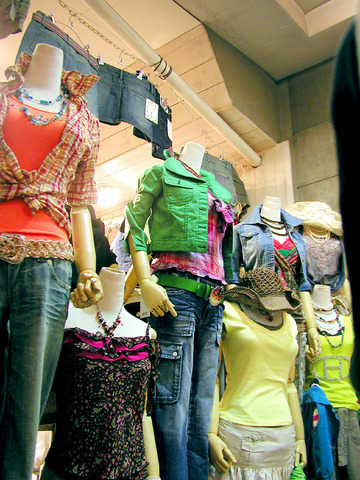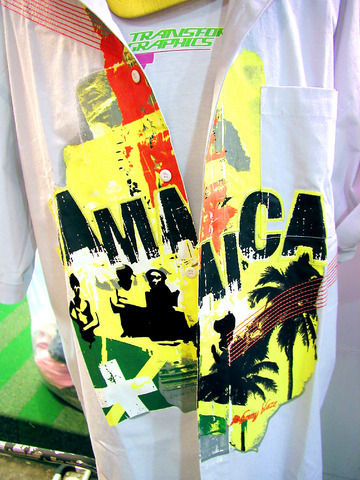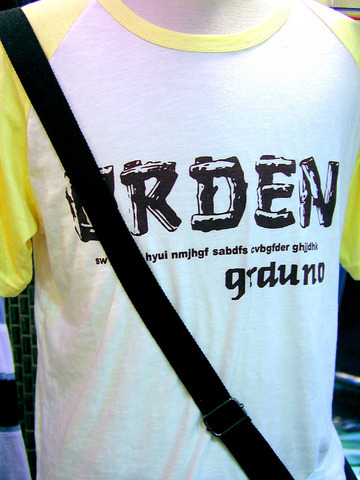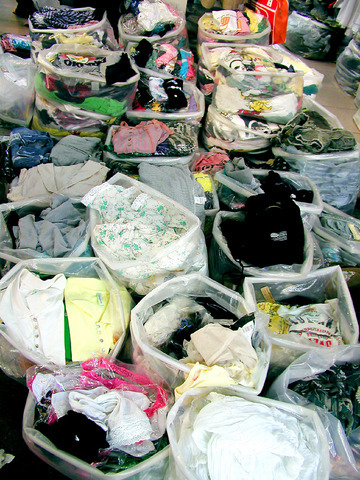The Wufenpu Garment Wholesale Area, as the popular clothing market opposite Taipei's Songshan train station is called, is a place that solves many of Taiwan's fashion mysteries in one fell swoop.
It's here in this semi-open-air market -- semi, because the goods spill out of the stores and onto the sidewalks and into the alleys -- where over 100 outlets supply a significant portion of the wardrobes favored by Taiwanese of all ages and fashion persuasions. And they do a brisk trade, with some stores selling by weight instead of item count, though single purchases of items are usually welcome.
Stores tend to specialize in specific fashion niches, such as trendy teeny-bopper gear, extra-large sizes, pet fashions, qipaos and pseudo-ethnic wear. Whatever their different specialties, they share a price range at the lowest end of the scale for clothes in Taipei.

PHOTO: MAX WOODWORTH, TAIPEI TIMES
"It's a race here to the bottom, price-wise," said one storeowner surnamed Chen (
Which is perhaps why Wufenpu has become a term that, when evoked in description of someone's fashion-sense, is intended to carry the sting of an accusation of poor taste and quality.
Popular actress Hsiao Shu-shen (

But despite the sneering aimed at the supposedly chintzy goods flooding out of Wufenpu, many people wandering the smart areas of Taipei are actually decked out in Wufenpu clothes and are making a fairly convincing show of having paid top dollar for their faux retro Mickey Mouse T-shirt or their sexy velour halter top. (Then again, some may have actually paid top dollar in East District boutiques for the clothes, but they would be suckers.)
It turns out that a lot of East District yuppies and hipsters, as well as teenagers mimicking pop star Jolin Tsai's (
But don't be fooled. The T-shirt with a Mary icon print and the words "Mary is my home girl" can be found at the market for about NT$200.

So before dropping a wad of cash for a DJ Guevara T-shirt or for an allegedly Nepalese skirt in front of the Dunhua South Road Eslite bookstore, savvy shoppers will make the trek to Wufenpu to pick them up for about NT$200 each.
Wufenpu is at its busiest on Mondays, as vendors from all parts of Taiwan come to stock up on goods that are later sold at night markets and stores. Using rapidly flashed hand signals, vendors haggle over prices for enormous bundles of clothes, which are then transported out of the narrow alleys behind scooters specially rigged with carts to the train station or to waiting courier trucks. From there, the clothes fan out around the city and the rest of Taiwan.
How the clothes reach Wufenpu, however, is a matter of considerable debate. The typical claim from vendors at the market for the provenance of their clothes is that they come from Hong Kong, Thailand and Japan. One vendor, however, confided that most of the products, in fact, were made in Taiwan.

Either way, the sheer volume of knock-off goods provides ample reason to question how forthright the stores are about their products. But judging from the number of customers, no one seems to dwell on the point.
The market fulfills a huge range of fashion demands for all ages and that's good enough for most. And with its low prices, the market guarantees that the winds of fashion can change quickly without leaving everyone in the dust.

In Taiwan there are two economies: the shiny high tech export economy epitomized by Taiwan Semiconductor Manufacturing Co (TSMC, 台積電) and its outsized effect on global supply chains, and the domestic economy, driven by construction and powered by flows of gravel, sand and government contracts. The latter supports the former: we can have an economy without TSMC, but we can’t have one without construction. The labor shortage has heavily impacted public construction in Taiwan. For example, the first phase of the MRT Wanda Line in Taipei, originally slated for next year, has been pushed back to 2027. The government

July 22 to July 28 The Love River’s (愛河) four-decade run as the host of Kaohsiung’s annual dragon boat races came to an abrupt end in 1971 — the once pristine waterway had become too polluted. The 1970 event was infamous for the putrid stench permeating the air, exacerbated by contestants splashing water and sludge onto the shore and even the onlookers. The relocation of the festivities officially marked the “death” of the river, whose condition had rapidly deteriorated during the previous decade. The myriad factories upstream were only partly to blame; as Kaohsiung’s population boomed in the 1960s, all household

Allegations of corruption against three heavyweight politicians from the three major parties are big in the news now. On Wednesday, prosecutors indicted Hsinchu County Commissioner Yang Wen-ke (楊文科) of the Chinese Nationalist Party (KMT), a judgment is expected this week in the case involving Hsinchu Mayor Ann Kao (高虹安) of the Taiwan People’s Party (TPP) and former deputy premier and Taoyuan Mayor Cheng Wen-tsan (鄭文燦) of the Democratic Progressive Party (DPP) is being held incommunicado in prison. Unlike the other two cases, Cheng’s case has generated considerable speculation, rumors, suspicions and conspiracy theories from both the pan-blue and pan-green camps.

Stepping inside Waley Art (水谷藝術) in Taipei’s historic Wanhua District (萬華區) one leaves the motorcycle growl and air-conditioner purr of the street and enters a very different sonic realm. Speakers hiss, machines whir and objects chime from all five floors of the shophouse-turned- contemporary art gallery (including the basement). “It’s a bit of a metaphor, the stacking of gallery floors is like the layering of sounds,” observes Australian conceptual artist Samuel Beilby, whose audio installation HZ & Machinic Paragenesis occupies the ground floor of the gallery space. He’s not wrong. Put ‘em in a Box (我們把它都裝在一個盒子裡), which runs until Aug. 18, invites